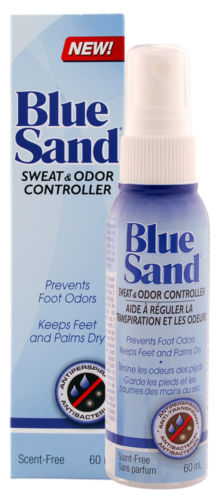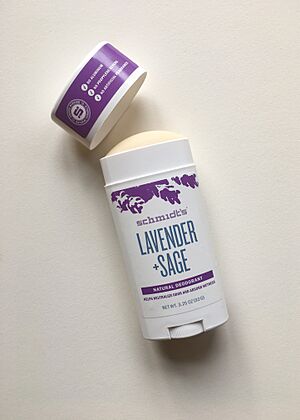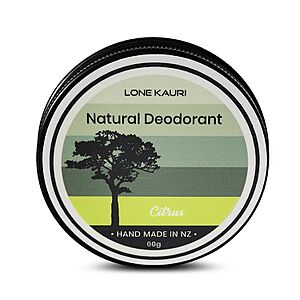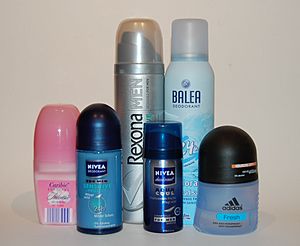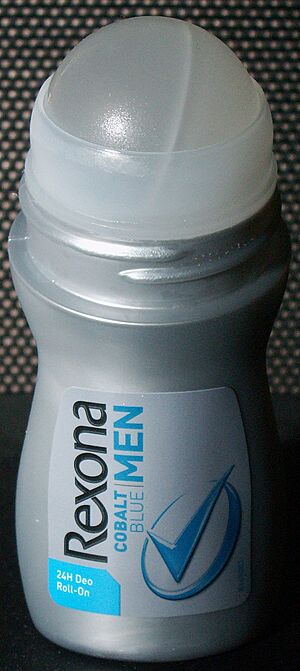Deodorant facts for kids
A deodorant is a substance applied to the body to prevent or mask body odor caused by bacterial breakdown of perspiration, for example in the armpits or feet. A subclass of deodorants, called antiperspirants, prevents sweating itself, typically by blocking sweat glands. Antiperspirants are used on a wider range of body parts, at any place where sweat would be inconvenient or unsafe, since unwanted sweating can interfere with comfort, vision, and grip (due to slipping). Other types of deodorant allow sweating but prevent bacterial action on sweat, since human sweat only has a noticeable smell when it is decomposed by bacteria.
In the United States, the Food and Drug Administration classifies and regulates most deodorants as cosmetics, but classifies antiperspirants as over-the-counter drugs.
The first commercial deodorant, Mum, was introduced and patented in the late nineteenth century by an inventor in Philadelphia, Pennsylvania, Edna Murphey. The product was briefly withdrawn from the market in the US. The modern formulation of the antiperspirant was patented by Jules Montenier on January 28, 1941. This formulation was first found in "Stopette" deodorant spray, which Time magazine called "the best-selling deodorant of the early 1950s".
Use of deodorant with aluminium compounds has been suspected of being linked to breast cancer, but research has not proven any such link.
Contents
History
In 1888, the first modern commercial deodorant, Mum, was developed and patented by a U.S. inventor in Philadelphia, Pennsylvania, Edna Murphey; the small company was bought by Bristol-Myers in 1931. In the late 1940s, Helen Barnett Diserens developed an underarm applicator based on the newly invented ball-point pen. In 1952, the company began marketing the product under the name Ban Roll-On. The product was briefly withdrawn from the market in the U.S., but it is once again available at retailers in the U.S. under the brand Ban. In the UK it is sold under the names Mum Solid and Mum Pump Spray. Chattem acquired Ban deodorant brand in 1998 and subsequently sold it to Kao Corporation in 2000.
In 1903, the first commercial antiperspirant was Everdry. The modern formulation of the antiperspirant was patented by Jules Montenier on January 28, 1941. This patent addressed the problem of the excessive acidity of aluminum chloride and its excessive irritation of the skin, by combining it with a soluble nitrile or a similar compound. This formulation was first found in "Stopette" deodorant spray, which Time magazine called "the best-selling deodorant of the early 1950s". "Stopette" gained its prominence as the first and long-time sponsor of the game show What's My Line?; it was later eclipsed by many other brands once the 1941 patent expired.
Between 1942 and 1957, the market for deodorants increased 600 times to become a $70 million market. Deodorants were originally marketed primarily to women, but by 1957 the market had expanded to male users, and estimates were that 50% of men were using deodorants by that date. The Ban Roll-On product led the market in sales.
In the early 1960s, the first aerosol antiperspirant in the marketplace was Gillette's Right Guard, whose brand was later sold to Henkel in 2006. Aerosols were popular because they let the user dispense a spray without coming in contact with the underarm area. By the late 1960s, half of all the antiperspirants sold in the U.S. were aerosols, and continued to grow in all sales to 82% by the early 1970s. However, the late 1970s saw two developments which greatly reduced the popularity of these products. First, in 1977 the U.S. Food and Drug Administration banned the active ingredient used in aerosols, aluminium zirconium chemicals, due to safety concerns over long term inhalation. Second, the U.S. Environmental Protection Agency limited the use of chlorofluorocarbon (CFC) propellants used in aerosols due to awareness that these gases can contribute to depleting the ozone layer. As the popularity of aerosols slowly decreased, stick antiperspirants became more popular.
Formulations
Common and historical formulations for deodorants include the following active ingredients:
-
- Aluminum salts (aluminum chlorohydrate, aluminum zirconium tetrachlorohydrex gly, and others) – used as the basis for almost all non-prescription (everyday) antiperspirants. The aluminum reacts within the sweat gland to form a colloid which physically prevents sweating.
- Alum (typically potassium alum or ammonium alum, also described as "rock alum", or "rock crystal", or "natural deodorant"). Alum is a natural crystalline product widely used both historically and in modern times as a deodorant, because it inhibits bacterial action. The word 'alum' is a historical term for aluminum sulfate salts, therefore all alum products will contain aluminum, albeit in a different chemical form from antiperspirants.
- Bactericidal products such as triclosan (TCS) and parabens kill bacteria on the skin.
- Alcohols and related compounds such as propylene glycol – these products can have both drying and bactericidal effects.
- Methenamine (hexamethylenetetramine, also known as hexamine or urotropin) is a powerful antiperspirant, often used for severe sweat-related issues, as well as prevention of sweating within the sockets of prosthetic devices used by amputees.
- Acidifiers and pH neutral products – deodorants that prevent bacterial action by enhancing (or at least, not depleting) the skin's natural slight acidity, known as the acid mantle, which naturally reduces bacterial action but can be compromised by typically alkaline soaps and skin products.
- Masking scents – other strong or overriding scents of a pleasing type may be used, used to mask bodily odors. Typically these are strongly smelling plant extracts or synthetic aromas.
- Activated charcoal and other products capable of absorbing sweat and/or smell. Although charcoal most often has a black color, the activated charcoal used in deodorants may be a very light color for aesthetic reasons.
- Less commonly used, products such as milk of magnesia (a thick liquid suspension of magnesium hydroxide) are sometimes used as deodorants. Many milk of magnesia products contain small amounts of sodium hypochlorite (bleach) at very low levels that are safe for ingestion and skin application. Sodium hypochlorite is a powerful bactericide, and it is possible that its presence in a product that can dry onto the skin, may explain this use as a deodorant. (Safety info: bleach is caustic and extremely poisonous, and can be lethal, in higher concentrations.)
Formats
Deodorants and antiperspirants come in many forms. What is commonly used varies in different countries. In Europe, aerosol sprays are popular, as are cream and roll-on forms. In North America, solid or gel forms are dominant.
Health effects
After using a deodorant containing zirconium, the skin may develop an allergic, axillary granuloma response. Antiperspirants with propylene glycol, when applied to the axillae, can cause irritation and may promote sensitization to other ingredients in the antiperspirant. Deodorant crystals containing synthetically made potassium alum were found to be a weak irritant to the skin. Unscented deodorant is available for those with sensitive skin. Frequent use of deodorants was associated with blood concentrations of the synthetic musk galaxolide.
See also
 In Spanish: Desodorante para niños
In Spanish: Desodorante para niños
- Air freshener
- Aluminum chlorohydrate
- Perfume


